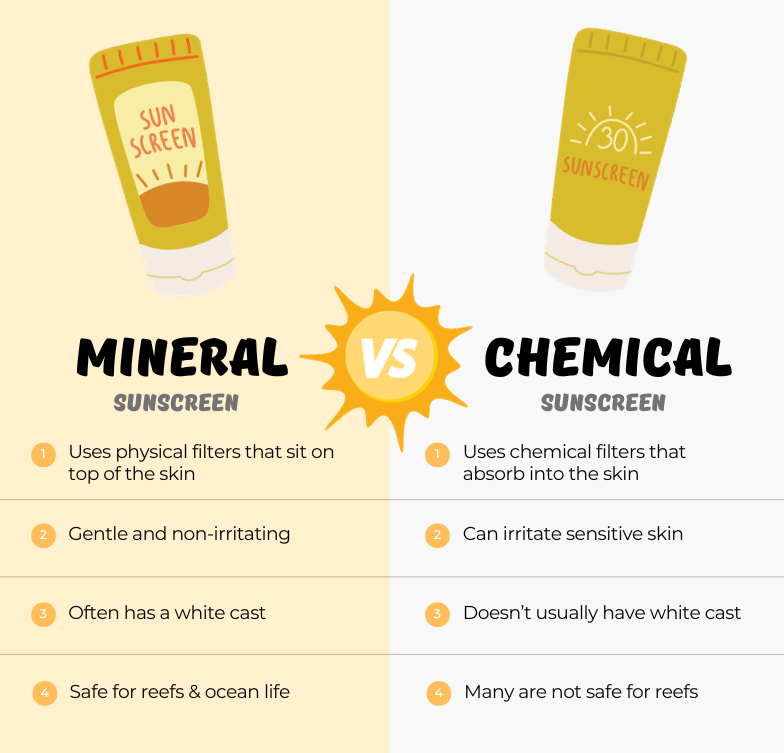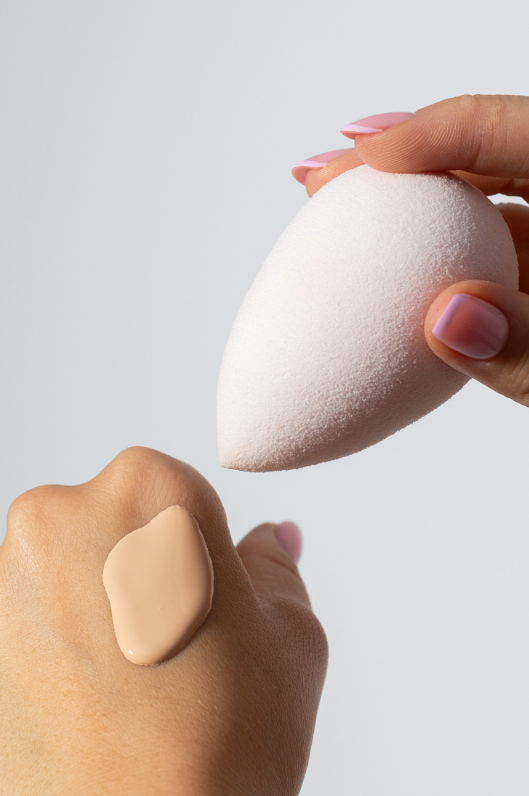You’ve slathered on the sunscreen, ready to face the sun’s rays, only to glance in the mirror and find yourself looking like a ghostly apparition — yikes! Is it Halloween already?
Fear not, dear sunshine warrior! We’re here to bring you the ultimate guide to vanquishing the dreaded white cast.
But first, let’s understand what is white cast in sunscreen. Get ready to embrace sun protection without sacrificing your natural glow.
Key Takeaways: The Need-To-Know
- Avoid white cast by choosing chemical filter sunscreens over physical mineral ones — just know chemical sunscreens tend to irritate sensitive skin.
- You can lessen your chances of white cast with physical mineral sunscreens by applying lotion in thin layers and rubbed in thoroughly.
- Choose tinted sunscreens for mineral formulas, as the tint counteracts the white cast.
- Another option is to go with cUPF clothing, a sun hat, or an umbrella.
Why Does White Cast Happen? The Basics
Ah, sunscreen white cast—the sun protection world’s equivalent of a clingy party guest who doesn’t get when they’re not wanted (please, go away).
White cast is that visible residue left on the skin after applying sunscreen, often appearing as a white or ashy tint, especially on darker skin tones.
You can thank titanium dioxide and zinc oxide for this spooky phenomenon.
Titanium dioxide and zinc oxide are often found in physical mineral sunscreens, protecting your skin from the sun’s rays by reflecting UV radiation like an invisible shield. And we thank them for their service — they’re great at combating the sun’s harmful rays and keeping our skin safe.
But the downside is that these notorious ingredients can give your skin a “snowy” look due to their thicker consistency and reflective properties. They sit atop the skin like a layer of snow, reflecting UV rays and leaving you with a dazzlingly white cast after applying.
Why does this happen with titanium dioxide and zinc oxide found in physical mineral sunscreens, but doesn’t happen with chemical sunscreens? The secret lies in how the sunscreen filters function.
Tips on How to Get Rid of White Cast
Equipped with the understanding of sunscreen types and ingredients, let’s explore some strategies to eliminate the white cast. Here are some tips:
1. Choose the Right Sunscreen Formula
The initial move in your fight against the white cast is picking the ideal sunscreen formula.
The short answer is: Mineral sunscreens leave a white cast, while chemical sunscreens do not.
So, just choose a chemical sunscreen and you’ll be good to go!
But truthfully, there a little more to it than that, and it’s worth understand why mineral sunscreens leave a white cast and chemical sunscreens do not.
Chemical Sunscreens: Ghost-Free, But More Irritating
Chemical sunscreens are like undercover agents in the world of sun protection. They’re subtle, sneaky, and don’t leave a trace.
You see, chemical sunscreens are absorbed into the skin, and absorb UV radiation for you.
These chemical sunscreen products are often lightweight and feel like a dream on the skin, making them perfect for those who want to keep their sun protection incognito.
The downside of chemical sunscreens is that they contain chemical filters like oxybenzone and octinoxate, which can be very irritating to sensitive skin folks.
Even sunscreens that proudly don’t contain oxybenzone and octinoxate (largely because these ingredients have been blamed for negatively affecting coral reefs) contain other chemical ingredients like avobenzone which — while generally not quite as irritating as oxybenzone and octinoxate, can still cause issues for the ultra-sensitive individuals.
Mineral Sunscreens: White Cast But Gentler on Skin
On the other side of the sunscreen spectrum, we have mineral sunscreens. Mineral sunscreens function a bit differently — they sit on top of the skin, rather than being absorbed into the skin.
They use titanium dioxide and zinc oxide to create a physical barrier that reflects UV light, saving your skin from the sun’s evil rays. However, with great power comes great responsibility—or, in this case, the potential for a white cast.
Since these sunscreens rest on top of the skin and use a physical barrier to reflect the sun, they are more likely to cause a white cast due to their thicker consistency and reflective properties.
The upside is that mineral sunscreens are much gentler and easier on sensitive skin — after all, they aren’t being absorbed into your skin, so they are much less likely to cause irritation.
For this reason, these are the sunscreens we recommend for sensitive skin, psoriasis, rosacea, and other skin issues.

2. Apply in Thin Layers
Just as building a sandcastle involves layering without overpacking, so should you apply sunscreen in thin layers.
This approach helps minimize the appearance of white cast and ensures you’re getting the sun protection you need.
Start by applying a thin layer of sunscreen to your skin, allowing each layer to absorb before applying the next. This way, you’ll avoid looking like a spooky specter while still reaping the benefits of sun protection.
Remember to apply sunscreen 20 minutes before sun exposure to avoid looking like a lobster, and always reapply sunscreen regularly according to the bottle’s recommendations.
3. Pat, Don’t Rub
Simply put, when you rub sunscreen onto your skin, you’re disrupting the even layer of protection you’re trying to create, resulting in spotty coverage. You could inadvertently rub the sunscreen off certain sections of your face, leaving your skin more exposed than you bargained for!
Rubbing in sunscreen can also cause pilling on makeup, which is no fun at all.
Patting, on the other hand, tends to work more effectively — although it does require a bit more patience.
Patting on sunscreen allows the product to sink into your skin without overly disturbing it or moving it around. Dabbing the product on also encourages the sunscreen to sit on top of your skin rather than sinking into your pores— avoiding a pore-clogging catastrophe.
And of course, patting sunscreen also allows the mineral filters to disperse evenly, minimizing any chalky residue and lessening your risk of white cast.
Many suncare fanatics recommend using a makeup sponge to pat on sunscreen for ultimate application.

4. Opt for Tinted Sunscreens
Tinted sunscreens act as the chameleons of sun protection, harmonizing with your skin tone while still offering UV defense.
These handy sunscreens can help counteract the appearance of white cast, especially on light and medium skin tones.
Tinted sunscreens not only provide UV protection but also give your complexion a little extra oomph. They offer both sun protection and light coverage for the skin, so you can look good and stay safe at the same time.
Need some ideas? Read about our recommendations for the best mineral sunscreens for face use (packed full of tinted sunscreen options).
Caring for Your Skin: Beyond Sun Protection
While sunscreen plays a crucial role in shielding your skin from harmful UV rays, it’s beneficial to extend some additional care by integrating supplementary sun protection strategies.
After all, it’s easy to forget to reapply at proper intervals, and many people are just terrible at properly applying sunscreen (especialy spray sunscreen) resulting in patchy coverage that invites the sun’s rays to sneak in and cause skin damage.
To further shield your skin from the sun’s wrath, consider using:
- UPF clothing
- Sun hats
- UV umbrellas
- Seeking natural sources of shade like shady trees and buildings
These additional layers of protection will help keep your skin’s surface safe and healthy, so you can enjoy the sunshine without worry.
In our quest to banish the dreaded white cast, we’ve learned about the different types of sunscreens, identified the ingredients that cause white cast, and discovered tips for getting rid of it.
By choosing the right sunscreen formula, applying in thin layers, rubbing in thoroughly, and opting for tinted sunscreens, you can embrace sun protection without sacrificing your natural glow. So go forth, dear reader, and enjoy the sunshine without fear of turning into Casper the friendly ghost.
FAQs on Getting Rid of White Cast
How do you prevent white cast from sunscreen?
To prevent a white cast from appearing after applying sunscreen, reach for a chemical sunscreen that absorbs into the skin, rather than sits on top of it. Alternatively, if your skin is sensitive to chemical sunscreens, try using a tinted mineral sunscreen to combat white cast.
Do all physical sunscreens leave a white cast?
In short — yes, pretty much. Unfortunately, most physical sunscreens are made with titanium dioxide and zinc oxide which cause a white cast, leading to an ashy look. If you want to stick with physical mineral sunscreens but want to avoid a white cast, be sure to rub the sunscreen thoroughly, apply thin layers repeatedly instead of one big carpet of lotion, and opt for tinted formulas.
What is a good body sunscreen no white cast?
For unbeatable sun protection without leaving a white cast, opt for chemical sunscreens that are easy to cover your body with, like spray sunscreens. Since body skin tends to be less sensitive than the face, even people with sensitive skin may be able to get away with using a chemical sunscreen for their body and using a tinted mineral sunscreen for their face.
Do white casts fade?
This can depend on the specific sunscreen brand and formula. While some older, traditional sunscreens might maintain that ghostly pallor, many contemporary mineral sunscreens are speedily joining the “no-white-cast” club.
Many modern formulations are more finely milled or tinted, helping the product blend smoothly into the skin and reducing that dreaded white cast. Meaning, you might start off looking a bit like Casper’s cousin, but with a little effort and some generous blending, it should fade into your skin nicely.
What is white cast on skin?
White cast is a visible layer of sunscreen that gives skin an ashen or grayish appearance. And the culprit causing this supernatural sheen? It’s usually the mineral blockers, such as zinc oxide and titanium dioxide, found in physical sunscreens. These ingredients sit on top of the skin, bouncing away harmful UV rays like an overzealous bouncer at a night club. The price for their UV-ousting vigilance? That annoying white residue sitting on your skin.
The good news is that modern sunscreens are ditching the ‘ghost look’ for a formula that dries clear. Dabbling in sunscreen no longer means flirting with phantom-fashion, making your sun protection journey decidedly less spooky!
What causes white cast?
To stay one step ahead of the white cast, you’ll need to know which sunscreen ingredients are likely to cause it. As we’ve mentioned, titanium dioxide and zinc oxide are the main culprits when it comes to white cast — these are the physical blocker ingredients to avoid if you want to bypass white cast.

